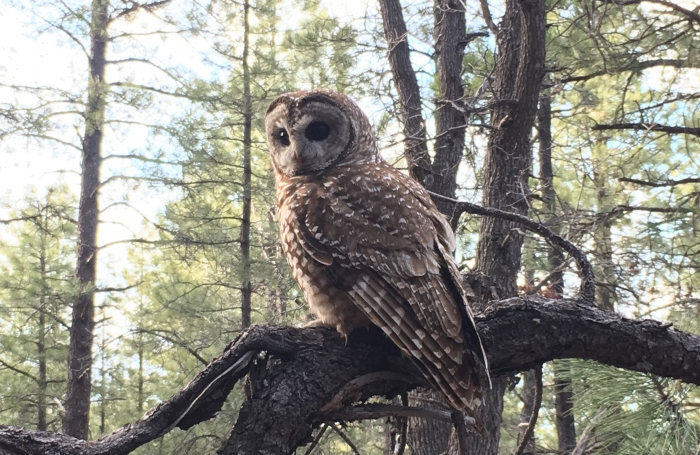Chemist Kevin Gaddis has adapted components of a high-pressure ion chromatography system to withstand the extreme conditions of a hot cell. (Photo: ORNL/Carlos Jones)
An Oak Ridge National Laboratory researcher has built a device that can speed up the separation of the medical radioisotope actinium-225 from irradiated thorium targets and withstand the high-radiation environment of a hot cell. In July, ORNL announced that Kevin Gaddis, a chemistry technician at the lab, had built and tested a prototype and was working to secure a patent for a device that cut separations time by 75 percent.
Left: The University of Texas at Austin SBD Challenge team: from left, Michael Butero, Matthew Frangos, Daniel Gutierrez, and John (Jack) Whelan. Right: The University of Rhode Island team: from left, Jay Macchia, Sean Babin, and Peter Tillinghast. (Photo: NNSA)
The National Nuclear Security Administration's Office of Nonproliferation and Arms Control has been partnering with national laboratories and universities to introduce engineering students to the field of international safeguards. Safeguards ensure that nuclear material and facilities are not used to illicitly manufacture nuclear weapons, the NNSA noted in a July 27 article.
Nicholas Thompson of LANL helps set up the neutron clustering measurements at the Walthousen Reactor Critical Facility at Rensselaer Polytechnic Institute in Schenectady, NY. (Photo: LANL)
A statistically predicted tendency for neutrons produced inside fission reactors to form in clusters can cause asymmetrical energy production that is counterbalanced, at least in part, by the spontaneous fission of radioactive material in the reactor.
The Plutonium Facility at Los Alamos National Laboratory. (Photo: LANL)
The Defense Nuclear Facility Safety Board, which provides independent federal oversight of Department of Energy weapons facilities, has reported that low-level radioactive and other combustible waste is accumulating in the basement of Los Alamos National Laboratory’s Plutonium Facility (PF-4), and that housekeeping and waste management in the PF-4 basement have been a continuing challenge.
The Mexican spotted owl, which finds a home in northern New Mexico’s canyons and forests, is a threatened species that the DOE strives to protect. Photo: Don Ulrich, taken in Flagstaff, Ariz.
To protect a treasured ecological species of northern New Mexico, the Los Alamos Field Office (EM-LA) of the Department of Energy’s Office of Environmental Management and its contractor N3B this month began their annual task of modifying legacy waste cleanup activities at Los Alamos National Laboratory ahead of the Mexican spotted owl breeding season.
The U.S. Fish and Wildlife Service (USFWS) listed the owl as a threatened species in 1993, when population numbers were decreasing drastically due to the loss, degradation, and fragmentation of their habitat.
 A special issue of the ANS journal Nuclear Technology, published last month, observes the 75th anniversary of the Trinity experiment, the world’s first nuclear explosion, on July 16, 1945, near Alamogordo, N.M. The experiment was a first step toward the conclusion of the Manhattan Project and the end of World War II. The special issue, The Manhattan Project Nuclear Science and Technology Development at Los Alamos: A Special Issue of Nuclear Technology, was sponsored by Los Alamos National Laboratory and curated by Mark Chadwick.
A special issue of the ANS journal Nuclear Technology, published last month, observes the 75th anniversary of the Trinity experiment, the world’s first nuclear explosion, on July 16, 1945, near Alamogordo, N.M. The experiment was a first step toward the conclusion of the Manhattan Project and the end of World War II. The special issue, The Manhattan Project Nuclear Science and Technology Development at Los Alamos: A Special Issue of Nuclear Technology, was sponsored by Los Alamos National Laboratory and curated by Mark Chadwick.










 The ANS Young Members Group (YMG) is delivering an in-depth look at the Department of Energy’s national laboratories through a series of live webinars called Spotlight on National Labs. The third and most recent webinar attracted more than 1,000 participants who were keen to learn about the mission and key projects of Los Alamos National Laboratory.
The ANS Young Members Group (YMG) is delivering an in-depth look at the Department of Energy’s national laboratories through a series of live webinars called Spotlight on National Labs. The third and most recent webinar attracted more than 1,000 participants who were keen to learn about the mission and key projects of Los Alamos National Laboratory.